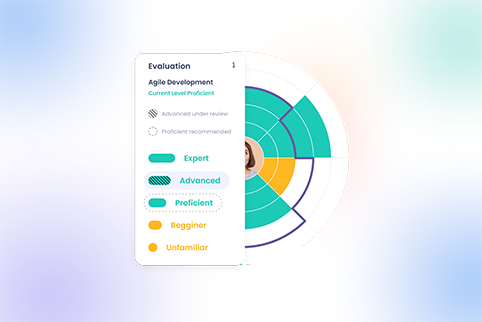
Objectives and Key Results (OKRs) and Agile/Scrum are two of the most popular and powerful management frameworks with wide adoption by businesses of all sizes. When trying to implement them together for the first time, companies seldom find themselves struggling with how to make them work in tandem.
This is an even greater challenge for organizations adopting OKRs in technical teams that have been using Scrum for a long time as a project management tool, and where teams regard OKRs as an overlap with Scrum that needs redundant reporting.
OKRs are an amazing power-up for a company’s Agile practices.
But this could not be further from the truth! OKRs and Scrum are not redundant frameworks, and actually, they complete and build upon each other perfectly. When used in the right way, OKRs are an amazing power-up for a company’s Agile practices and help create a results-oriented culture.
The easiest way to think about OKRs and Scrum together is to separate the Why, What, and How:
- Objectives should be directly aligned with the vision and mission of the organization and define the Why.
- Key Results define What needs to be accomplished in order to achieve the Objectives
- Scrum defines How to manage the actions that need to be taken on a weekly basis in order to achieve the Key Results.
With that in mind, let’s dive into the specifics of what OKRs and Scrum mean and how we can make them work together.
What are OKRs and why should business leaders care about them?
OKRs represent a collaborative management methodology that helps companies set a True North by having the entire organization focus their effort in the same direction and committing to common goals.
It brings a streamlined way of aligning what team members and teams strive to achieve with the organization’s desired outcomes, creating lasered focused value-driven teams.
Originally developed in the 1970s at Intel and introduced at Google in 1999 by Kleiner Perkins investor John Doerr, OKRs have gotten fast traction not only in massive corporations but also in emerging startups due to their ability to drive growth and innovation at scale.
Objectives are meant to set a clear path to follow in the next period for the entire organization. Key Results show what the teams engage themselves to do to reach the Objective.
As the name suggests, they are based on two key concepts — Objectives and Key Results — that come together in a hierarchical way to provide measurable organization-wide results:
- Objectives are meant to set a clear path to follow in the next period for the entire organization. This period is the next time horizon for the company achievements and is usually represented by quarterly cycles and less common annual ones.
- Key Results are assigned under each Objective and show What the teams engage themselves to do to reach the Objective.
Objectives and Key Results are not finite, achieved or not type of goals and it is highly recommended that they are quite ambitious. The end of the quarter is a great time to review the overall objectives and take the learnings from the current time period to adjust for the upcoming quarters.
Thus, 60-70% is the ideal completion percentage that an organization should target to achieve. If all the Objectives are graded as 100% complete this is a sign that you have not been ambitious enough when setting them.
What are the particularities of Agile/Scrum?
The questions that remain to be answered are what do we need to do at a more granular level, what does each team member in an organization focus on a weekly basis. This is where an Agile methodology such as Scrum comes in.
Scrum is a widely adopted project management methodology that started as a framework focused on agile software development but which has become indispensable across a large number of industries from various segments. Scrum is an iterative process that focuses on delivering continuous value for the customer by ensuring transparency, accountability, and agility in adapting to the customer’s needs.
Scrum runs in smaller time frames, called Sprints, that can run anywhere from one week to one month. The scope of this breakdown is to allow frequent small adjustments and reorganization of the scope of work for a team so that it reduces overall project risk and increases the quality of services or products.
Active communication is an important factor in the success of each Sprint and the overall Scrum implementation. This is carried out through team meetings that take place at the beginning, the end, and key points throughout the Sprint, called Scrum ceremonies.
Ceremonies ensure that everyone is on the same page, proactive and any small deviations can be adjusted in time so that at the end of the Sprint the team reaches the initial set goal. The four ceremonies in Scrum are:
- Sprint Planning – at the beginning of each sprint the team meets and decides what needs to be completed in the Sprint
- Daily Scrum – a short daily meeting where progress is shared by everyone
- Sprint Review – a meeting during which the team shows and demos the outcomes of the current Sprint
- Sprint Retrospective – at the end of each sprint the team gathers and analyses what went well and what not, so they can take the learnings from the current sprint to the next one.
Scrum allows teams to track progress and be very responsive to fast-changing business realities.
When implementing the methodology with all the corresponding ceremonies, Scrum allows teams to track progress and be very responsive to fast-changing business realities.
How to successfully combine OKRs with Scrum
We’ve seen that both methodologies yield excellent results, but how can we make them work together to obtain even greater outcomes? Though it may seem to some that OKRs are overlapping with Scrum, they actually complement the Agile methodologies and fill in some of the missing parts of Scrum.
As Scrum runs in iterations and focuses a lot on the development process itself, it can be easy for teams to get caught in feature development and lose sight of the business results that need to be achieved. We can even argue that building features that do not set the company one step closer to the desired business outcomes can do more damage than good as they introduce unnecessary complexity.
The first step for a successful rollout of OKRs in a Scrum team is to focus on changing the mindset inside the team.
The first step for a successful rollout of OKRs in a Scrum team is to focus on changing the mindset inside the team. The team’s purpose needs to change from delivering features described by the customer to a bottom-up approach where the team takes its own decisions on what product features need to be released in order to achieve the success criteria of the Key Results.
Objectives and their corresponding Key Results are set and reviewed quarterly while Scrum sprints have a higher cadence, running in smaller two weeks iterations. This sets the stage perfectly for acknowledging the progress made towards achieving the KR and reorganizing priorities from one sprint to the next.
The easiest way to make a correspondence between Scrum and OKRs from a component point of view is to consider that one or more Epics can be linked to a KR. Epics are defined in Agile as a volume of work that usually spans across multiple sprints and that can be divided into smaller user stories that fit into a single Sprint.
To ensure constant alignment throughout the quarter between the Sprint goals and the corresponding KRs, it is essential that OKRs are part of all Scrum ceremonies.
Objectives are set at the beginning of each quarter, as they define the broader goals of the organization. Each Scrum team then sets and agrees on a more granular set of Key Results that define ways of measuring success. To ensure constant alignment throughout the quarter between the Sprint goals and the corresponding KRs, it is essential that OKRs are part of all Scrum ceremonies.
Prioritize the project backlog putting the actions on top, that if taken in the Sprint will bring the team closer to achieving the OKRs.
The first ceremony in a Sprint that needs to be adapted is Sprint planning. Here the team should look at their KRs and prioritize the project backlog putting the actions on top, that if taken in the Sprint will bring the team closer to achieving the OKRs.
One thing to note is that not all KRs assigned to a team or a team member has to be part of the Scrum process, as OKRs can also refer to non-development goals such as personal or growth objectives.
The Sprint Review meeting is a great time for the team to estimate how much closer are they to achieving their KRs, update the progress, and evaluate whether their effort resulted in the desired outcome.
Conclusion
OKRs set an organizational goal and a way of prioritizing Scrum actions with a focus on moving the needle for the overall business. In turn, Scrum ensures that the effort taken by teams at a more granular level does not lose sight of the bigger picture and allows for agile realignment so that results work towards achieving the OKRs.
The OKR methodology does not replace Scrum in any way, nor does it make it obsolete. When everyone involved has a common understanding of the components and the goal of each of these to frameworks, the merge of these two can be a very powerful combination that empowers people inside the organization, increases focus, and drives business growth and innovation.








